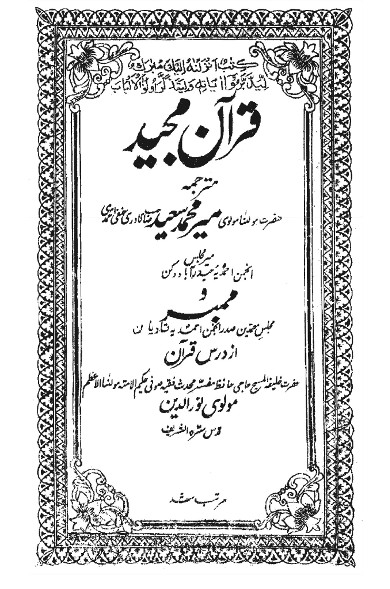Mīr Muḥammad Saʿīd (d. 1924) authored the first complete Ahmadi Urdu translation of the Qur’an, which was published in 1915 under the title Qurʾān Majīd Mutarjam: maʿa tafsīr awḍaḥ al-Qurʾān musammā bih tafsīr-i aḥmadī. Originating from Hyderabad, Mīr Muḥammad Saʿīd held the position of local chairman (amīr) within the Ahmadiyya movement. According to Ahmadi sources, he came from a family affiliated with the Qādiriyya Sufi order and had a significant following prior to joining the Ahmadiyya movement and pledging allegiance to Mirza Ghulam Ahmad.

Although Saʿīd resided in Hyderabad, he frequently visited Qadian where he had the opportunity to interact with Mawlawī Nūr al-Dīn, who delivered daily Qur’an lectures in the Aqsa mosque. Nūr al-Dīn was the first Ahmadi to pledge allegiance to Mirza Ghulam Ahmad and became his successor after his passing in 1908, and his lectures provided an important platform for members of the nascent movement to delve into the Qur’an’s meaning. Several attendees took copious notes during these lectures and published their own translations: one such attendee was Mir Saʿīd, who published his translation a year after Nūr al-Dīn’s demise.
The initial edition of Mīr Muḥammad Saʿīd’s translation was released in two volumes in Agra. Recently, the Jamaat-i Ahmadiyya has made available an online edition of this work, but the exact date of publication is not specified. The editors claim that the content of the translation remains unaltered in this new edition, and that any modifications have been limited to the layout, such as replacing endnotes with footnotes, to enhance the readability of the translation.
The translation appears to have a primary focus on issues of interest to the Ahmadi community, with particular attention given to Ahmadi-related aspects. This can be attributed to the fact that the manuscript was initially reviewed by Ahmadi scholars and authorized for publication by Bashīr al-Dīn Maḥmūd Aḥmad, the second caliph of the community. Consequently, this translation can be considered as constituting the first officially approved Ahmadi translation. Previous Ahmadi translations were more individual projects intended to support the religious education of the growing movement. In contrast, Saʿīd’s translation underwent an approval process, lending it an official character, as is evident from its title (tafsīr-i āḥmadī). Interestingly, the title page mentions not only Saʿīd’s affiliation with the Jamaat-i Ahmadiyya, but also his Qādirī and Ḥanafī background.

Furthermore, the information given in the introduction indicates that the choices made in the translation and the explanations given in the additional commentary on the verses are largely influenced by Nūr al-Dīn’s lectures, which Saʿīd claims strongly align with Shāh Walī Allāh’s Persian translation. Although Saʿīd does not provide concrete evidence to support this statement, the mention of Shāh Walī Allāh (d. 1763) clearly demonstrates that Saʿīd is presenting his translation as following the tradition of a recognized translation that is popular within scholarly circles. Moreover, it signifies that Ahmadi scholars, who were familiar with Persian, studied and utilized Shāh Walī Allāh’s work. Saʿīd also emphasizes the exegetical principles of the Ahmadiyya and asserts that his translation stands out due to its intratextual approach to Qur’an interpretation (tafsīr al-Qur’an bi l-Qur’an), as well as stressing that it does not contradict any authentic ḥadīths traceable back to the Prophet himself. This assertion implies that his work offers a more accurate translation by employing, according to his view, the best and most appropriate principles through which to understand and interpret the Qur’an, thereby presenting a faithful rendition of the source text.
He applies this approach, for instance, in his translation of Q 3:55, which he renders as ‘O Jesus, I will cause you to die (innī mutawaffīka).’ Saʿīd refers to Q 39:42 to justify his decision, claiming that tawaffā can mean either the temporary taking of the soul (i.e., sleep) or the permanent taking of the soul (death). He rules out any other possibilities, thus opposing the majority of Sunni exegeses that assume Jesus did not die but ascended to heaven with his physical body. Hence, Saʿīd upholds the classical Ahmadiyya perspective on this verse, using it as evidence of Jesus’ death.

Mir Saʿīd’s work marks the first complete translation published by Jamaat-I Ahmadiyya, but it is difficult to ascertain its influence and impact on Ahmadis. Ahmadi sources do not mention the publication of a second edition, which indicates that demand was limited. This may have been due to the fact that several, albeit partial, translations, were already in circulation and studied by Ahmadis. Furthermore, Mīr Saʿīd’s rendition was followed by the publication of other translations inspired by Nūr al-Dīn’s lectures and written by his students, and these steadily increased the range of available translations.
Kamran Ahmad Khan
